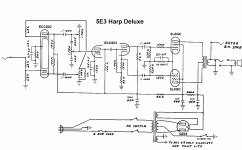I was wondering if I could overdrive the input of one of my amp channels with the output of the other channel. I have an Ampeg B25 (schematic linked) and I was thinking about removing the 270K resistor between the channel 1 pre-amp out and the power section input and connecting the output of that channel to the input of channel 2 so I can overdrive it. Do I run the risk of breaking something in the channel 2 pre-amp section if I do that?
Thanks for viewing! Below is the link to the schematic.
http://www.drtube.com/schematics/ampeg/b25-jp.gif
Thanks for viewing! Below is the link to the schematic.
http://www.drtube.com/schematics/ampeg/b25-jp.gif
 Moved to I & A. Please post all music amplifier questions to the Instrument & Amps forum per forum policy. Make note of the sub-headers in the forum title.
Moved to I & A. Please post all music amplifier questions to the Instrument & Amps forum per forum policy. Make note of the sub-headers in the forum title. Instruments and Amps Everything that makes music, Especially including instrument amps.
and
Tubes / Valves All about our sweet vacuum tubesThreads about Musical Instrument Amps of all kinds should be in the Instruments & Amps forum
Moved to I & A. Please post all music amplifier questions to the Instrument & Amps forum per forum policy. Make note of the sub-headers in the forum title.
and
Thanks!
yes it works well but you may have to put in a resistor to lower the max gain. this will fix the oscillationproblems and still give good overdrive. both my harmonica amps are done like this the first was a 5e3 fender clone that i moded to be like this.( see attached ) my new amp is based on the first one but with a few differences worked out latter. havn't drawn up the working schematic for it yet.
Attachments
I followed Jerry Garcia's approach, and put one channel of an Alembic preamp output into the input of the other channel (with a pot between, and another pot at the power amp input). 1 volume pot on guitar, 1 volume pot in 2-stage first channel, 1 volume pot between channels, 1 volume pot in 2-stage second channel, 1 master volume pot at power amp.
Not only does it have a wonderful overdrive, it also has a wonderful bright clean available if you twist a few knobs! Lots of 'bright' high-treble boost requires throwing away lots of gain in the tone stacks; this gives you two tone stacks in series. That's the real advantage! You can control the tone before and after the distortion is generated, so one of my favoite settings is very bright and treble in the first channel, then make some distortion, then cut the treble in the second channel. The guitar comes thru bright and articualte enough, while the harmonics are very complex and chords and bends sound great, meaty and beaty, yet the distortion is not all bright buzz and irritating.
Consider an on/off switched volume pot instead of the second input jack for the second channel. Lets you run thru just the second, or thru both. A relay and footswitch is even better.
Not only does it have a wonderful overdrive, it also has a wonderful bright clean available if you twist a few knobs! Lots of 'bright' high-treble boost requires throwing away lots of gain in the tone stacks; this gives you two tone stacks in series. That's the real advantage! You can control the tone before and after the distortion is generated, so one of my favoite settings is very bright and treble in the first channel, then make some distortion, then cut the treble in the second channel. The guitar comes thru bright and articualte enough, while the harmonics are very complex and chords and bends sound great, meaty and beaty, yet the distortion is not all bright buzz and irritating.
Consider an on/off switched volume pot instead of the second input jack for the second channel. Lets you run thru just the second, or thru both. A relay and footswitch is even better.
- Status
- This old topic is closed. If you want to reopen this topic, contact a moderator using the "Report Post" button.
- Home
- Live Sound
- Instruments and Amps
- Overdriving one channel with another
